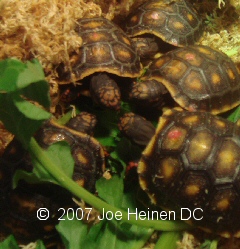
Introduction:
I first saw Redfoot tortoises at a reptile show 1990. There were quite a few adults tortoises at the show. These were obviously wild caught tortoises. Their shells were smooth and bore scars resulting from a life in the wild.
Over the years I noticed more juvenile Redfoot tortoises at the show and more recently there have been numbers of hatchlings. I was impressed by the personality of these young captive born Redfoot tortoises. They were very outgoing, curious about the activity around them. They showed little fear of people and even seemed to enjoy having their heads rubbed.
In 1996 my wife (Karen) gave me my first Redfoot Tortoise as a Fathers Day present. It was about 4" long. Over the next year I acquired 5 more about the same size. I currently have 10 adults in the breeding colony.
Natural History:
The Redfoot Tortoise (Chelonoidis carbonaria ) originates from central and northern South America. and Central America. It has also been introduced to several Caribbean islands.
They are a medium sized tortoise. The males are larger with a very concave plastron. The males also narrow mid section giving them the appearance of a waist. Color is variable. Some have intense red scales on the legs (hence the name) and head. While others are more yellow. In adults the carapace scutes are very dark brown to black with a yellow center. Hatchlings shells are more yellowish brown.
In the wild Redfoot Tortoises are found in a variety of environments from dry grasslands to humid forests. There seems to some disagreement as to which habitat they prefer. However mine seem to prefer more shady wet areas. In the summer they seem to be happiest submerged in a mud puddle. They are most active during and after a rainstorm. This often stimulates breeding.
Redfoot Tortoises are primarily herbivorous, though they are known to eat carrion as well as any bug they can catch. Here I have seen them devour slugs, worms and pill bugs.

